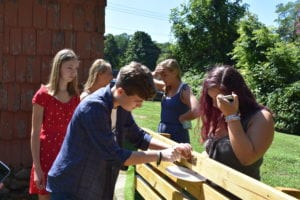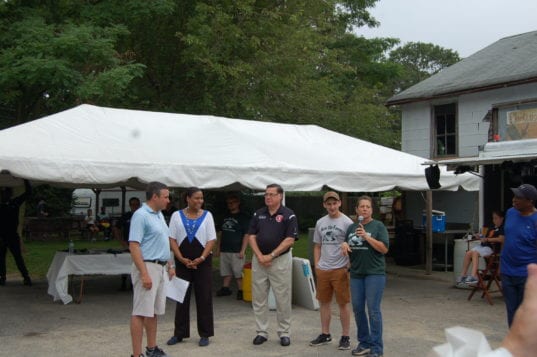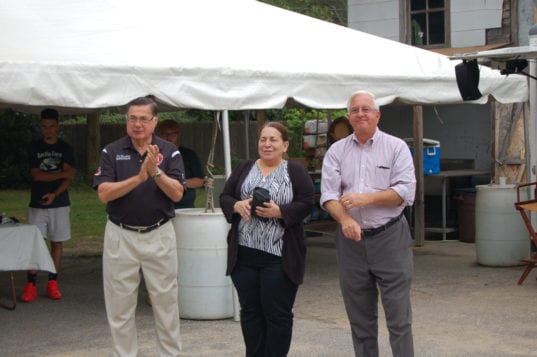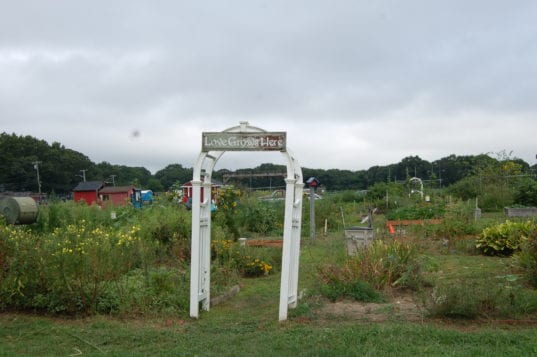A local task force recently took part in a vital water testing project and chose the Village of Poquott to accomplish its task.
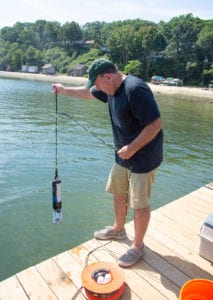
George Hoffman, co-founder of Setauket Harbor Task Force, said the organization participated in Shell Day Aug. 22 when the group tested water from the Village of Poquott’s new dock. Shell Day is a six-state water monitoring event coordinated by Northeast Coastal Acidification Network. NECAN, which serves as an interface between research and industry interests, enlisted 50 water quality groups run by citizen scientists to test for levels of ocean acidification along the harbors and bays from Maine to the Long Island Sound.
Covering more than 600 miles of the U.S. Northeast coast, the testing will give scientists a broader picture of the extent of acidification that comes into the ocean from harbors and bays.
“[Acidification] is having impacts on shellfish and baby fish,” Hoffman said. “The problem with a higher acid content of the water is that it starts to impact the shell of the baby shellfish as they are emerging. It weakens the shells and makes them more susceptible to die-offs, and they don’t survive. It’s just impacts the whole food chain.”
Hoffman said the task force tests water conditions in the Sound’s bays and harbors twice a year and was thrilled to participate in Shell Day. The Village of Poquott was the ideal spot for the testing, he said, due to its new dock in the middle of Port Jefferson Harbor, and the task force appreciated village officials allowing them to use the location.
Testing was done during three phases of the tide — low, mid and high — which took place at 11:18 a.m., 2:18 p.m. and 5:30 p.m. Hoffman said two water samples were taken from every phase of the tide and then put on ice. The samples were then sent by ferry to Bridgeport, Connecticut, where they will be analyzed at the University of Connecticut’s laboratory for alkalinity and salinity.
Poquott Mayor Dee Parrish said in an email the village was pleased that the dock, which was officially opened in June, was chosen. While the goal was to provide a place for residents to use for fishing, photography, summer lounging and social interactions, the testing on the dock was a first.

“Being able to assist the Setauket Harbor Task Force in obtaining the water samples that will provide actionable information for watershed management, strategic habitat protection and restoration is a really fabulous end of season way to celebrate our first year with this wonderful new community asset,” Parrish said.
Laurie Vetere, president of the Setauket Harbor Task Force, said in a statement that the group is eager to participate in every study that can determine the health of Port Jefferson and Setauket harbors
“We hope that our efforts on Shell Day 2019 will drive the local and regional governments to step up their efforts to improve the ability of our local waters to provide optimal habitats for our native and dwindling marine life,” Vetere said.
State Assemblyman Steve Englebright (D-Setauket), chair of the state’s Assembly Committee on Environmental Conservation, applauded the group’s efforts in a statement. Englebright is responsible for drafting legislation to establish Stony Brook University’s Ocean Acidification Task Force.
“The process of ocean acidification is invisible, and we need to have regional scientific datasets to bring the magnitude of this enormous threat to marine life into plain site and help us develop strategies to address its impacts,” Englebright said. “Time and again, we see that ordinary citizens are ready and willing to help with critical scientific data collection. Shell Day 2019 is a powerful and inspiring example of how we can bring citizen scientists together with leading government agencies to make a real difference.”



